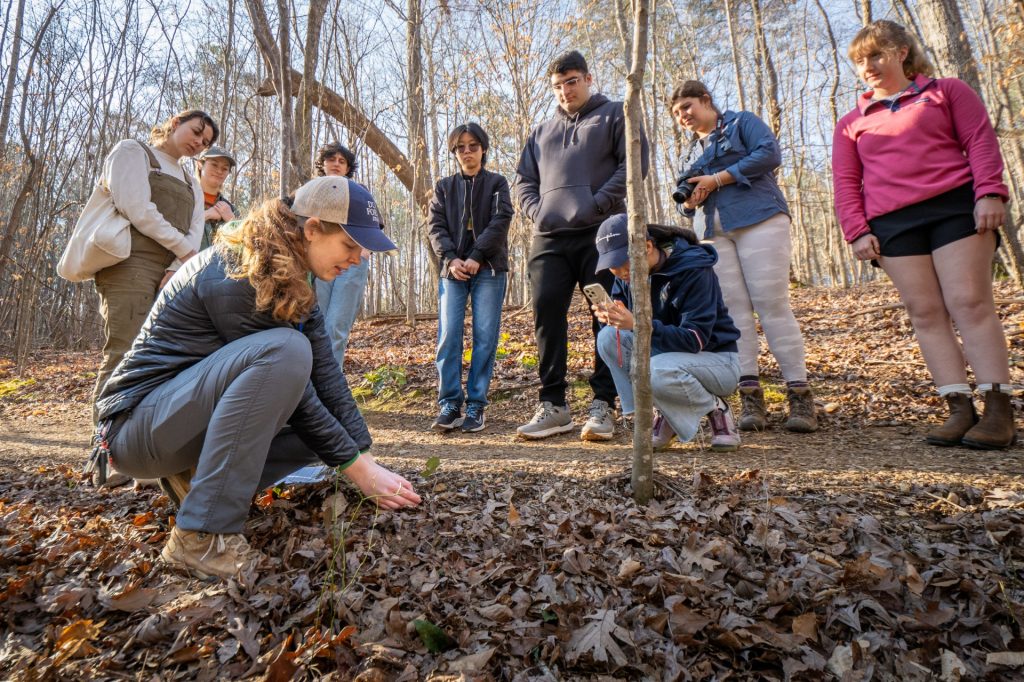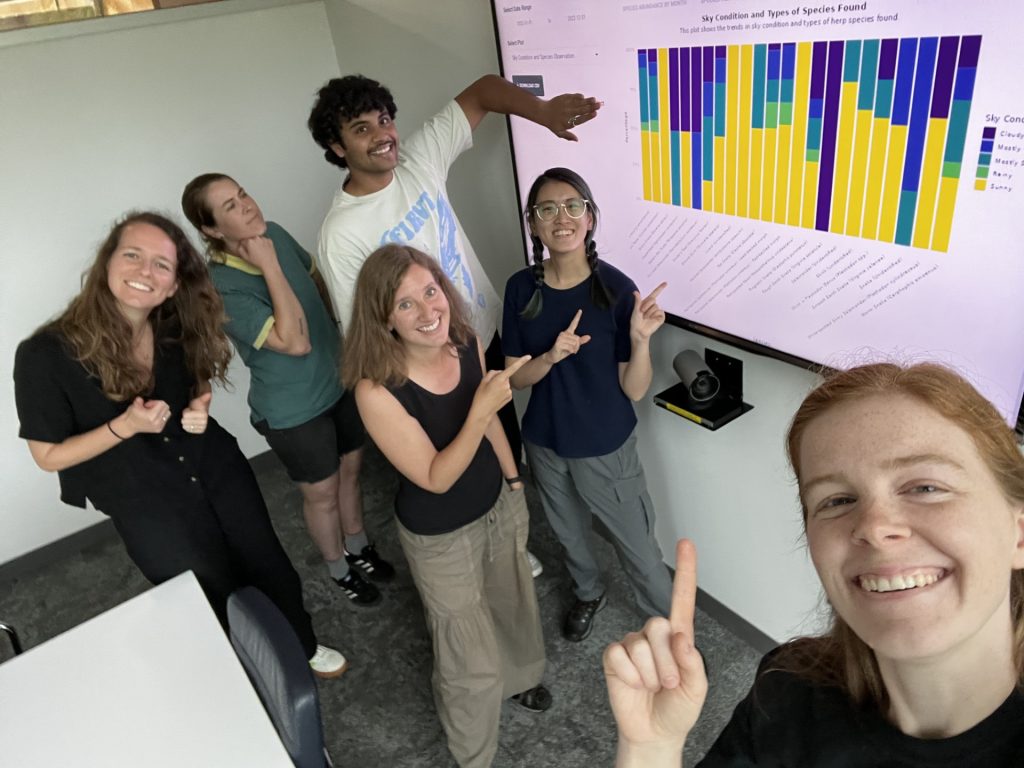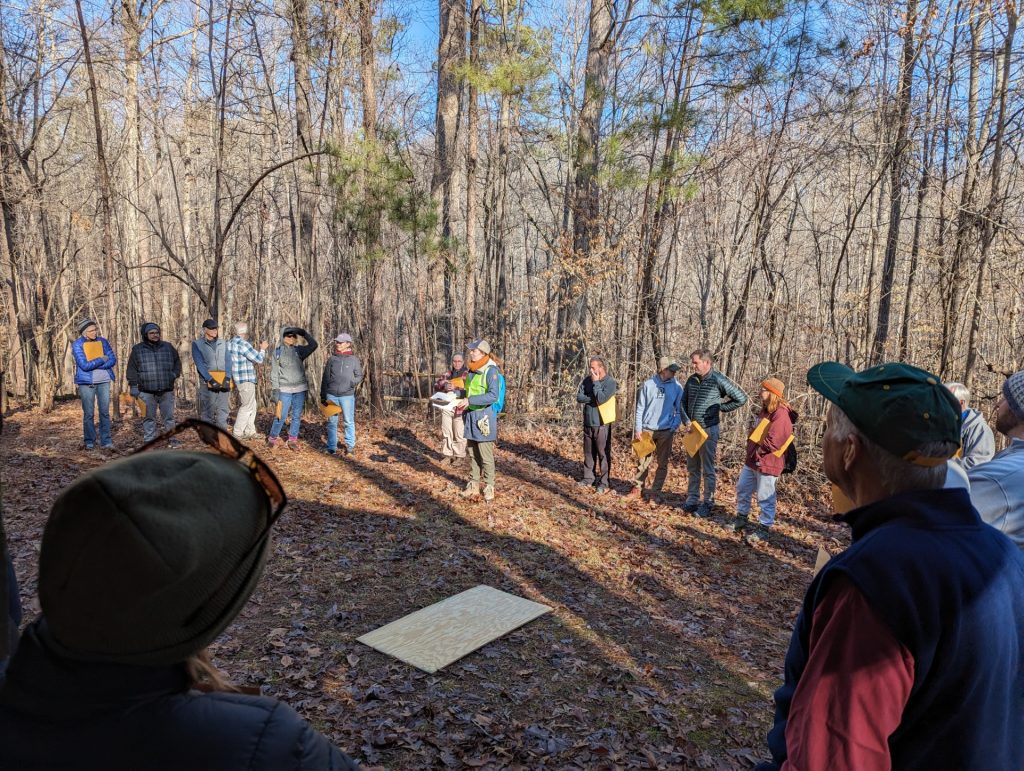
Photo credit Bill Snead, Duke University Communications.
For a few lucky people at Duke, a typical work day might include a walk in the woods. Take Maggie Heraty of the Duke Forest, for instance.
What is your job position?
As senior program coordinator for the Duke Forest, Heraty is involved in many projects. She manages two volunteer programs: the Herpetofauna Community Science Program, which collects data on reptile and amphibian populations, and the Forest Stewards Program, which divides volunteers into small teams to “monitor for the effects of recreation in the Duke Forest.”
Heraty is also involved with community engagement and leading tours, such as the annual tour of the Shepherd Nature Trail — which she describes as “one of our ‘core’ tour offerings” — along with a few other themed tours focused on flora and fauna, for instance, or a research tour about ongoing studies occurring in the Duke Forest. “Essentially,” Heraty says, “every season of the year we try to lead one tour… that’s just a free and open to the public tour.”
She also leads field trips or tours by request, such as for middle school programs, specific college classes, or Duke orientation groups.
What is your job like?
“Two weeks never look the same,” Heraty says. This week, she spent Monday and Tuesday wrapping up a Data+ project she’d been involved with this summer. Data+ is an interdisciplinary summer research program for undergraduate and graduate students. On Wednesday Heraty had a staff meeting and a meeting with the Nasher Museum of Art. The Duke Forest and the Nasher are planning a collaborative event focused on the Anthropocene to coincide with an upcoming exhibit at the Nasher called Second Nature: Photography in the Age of the Anthropocene. Later in the week Heraty would be reviewing reports from Forest Steward volunteers, and if time allowed, she would spend rest the of the week either quality controlling data from the herpetology project, helping update the strategic plan for the Duke Forest, or completing tasks for coordinating the Forest’s deer herd reduction program.
What is the deer herd reduction program?
Every year, from September to December, the Duke Forest partners with a select group of skilled hunters to reduce its overabundant white-tailed deer population. Historically, predators like mountain lions, black bears, and wolves kept the deer population in check, but “Humans have killed off all of the top predators in our ecosystem.”
“We now have coyotes who are making their way into this area and are kind of filling that niche a little bit,” Heraty says, but not enough to control an exploding deer population. The hunting program is a way to reduce it to healthier levels in the absence of natural predators.
Disease spreads more rapidly when the density of an animal population is too high, and the resources in an environment can only sustain a certain number of deer. Maintaining a more balanced deer population also supports plant diversity in the forest since having too many deer can decimate plants and slow forest regeneration.
What is the Duke Forest for?
The Duke Forest consists of 7100 acres in Durham, Orange, and Alamance Counties. It is managed by a staff of nine people, often along with a student intern or assistant. “We have a small, very dedicated team,” Heraty says.
The Forest was founded in 1931 and “has always been intricately linked with the university itself.” The primary mission of the Duke Forest is as a teaching and research laboratory in a “natural environment that is conserved and managed sustainably and that people can study.” Recreation and conservation are an “ancillary benefit,” but the Duke Forest is “not like your average state park or land conservancy.” Teaching and research are at the forefront of what the Duke Forest is for.
Researchers conduct many studies in the Duke Forest. Studies can be scientific, such as evaluating impacts of climate change or humans on the forest, but there are also studies on history, art, and engineering.

Photo credit Duke Forest staff; caption provided by Heraty.
How can people use the Duke Forest responsibly?
Balancing recreational use with the other missions can present challenges. The Forest Stewards volunteer program that Heraty oversees was created to help understand and address those issues. “The impetus for [the Forest Stewards program] was in the pandemic,” Heraty says, when people tended to “flock to outdoor spaces to get… a respite from quarantine.” That created a “huge uptick” in recreational use of the Duke Forest, which can have detrimental effects on land and ecosystems. The Forest Stewards act as “ambassadors” for the Forest and serve as “more eyes on the ground,” helping to notice and report issues like fallen signs or unauthorized trails.
Heraty says some of those unauthorized trails are established when people unknowingly follow incorrect directions on a hiking app. More people have started using apps like AllTrails and Strava, which can help people find and navigate new trails but can also lead to problems if someone follows an unauthorized trail while using the apps. Other users of the same app can then follow the same route.
To use the forest responsibly and avoid unauthorized trails or sensitive research sites, Heraty encourages visitors to refer to official websites and maps, which can both help you avoid getting lost and offer resources that “allow you to build more of a connection to the place that you’re visiting.” She suggests a free app called Avenza that lets you upload official Duke Forest maps ahead of time.
How does the Duke Forest balance the impacts of recreation with its other missions?
The Duke Forest encourages sustainable recreation while prioritizing research and conservation. “There’s always something intense happening in the world, and so going outside can be a respite for people, but also—sometimes there is a consumer mindset that happens there, where it’s just like, ‘I need to get in and get out… and never think about it again,’” Heraty says. “A culture that we’re interested in… instilling… is one where we all feel an actual connection to the land we’re living on.”
“Especially in our urbanizing and developing world… it’s really special that this place is preserved,” Heraty adds, and “engaging people in that stewardship mission is important.”

Photo credit Duke Forest staff.
What is your favorite thing about the forest, or something that might surprise us?
“The things I’m constantly amazed by in my job are really when I get to interact with teachers or researchers,” Heraty says. There are “so many brilliant people who are learning and thinking about the land or the forest.” One study that’s happened since Heraty joined the Duke Forest staff in 2021 was a UNC archaeological dig along New Hope Creek studying indigenous life. You can learn more about this research project in this article or this video.
Heraty also enjoys education and outreach, especially outside in the forest itself. Part of her background is in on-the-ground conservation stewardship, so “whenever I do get to actually be in the woods in Duke Forest, that is one of my favorite parts.” She enjoys helping to “interpret what people are seeing,” like explaining that a piece of flagging tape represents a research study or showing someone how to identify a tree.
What do you do for fun outside of work?
“I love reading sci-fi and fantasy,” Heraty says. Right now she’s reading a book called “Black Sun” by Rebecca Roanhorse, which a friend recommended. She is also involved with grassroots organizing for social justice groups and enjoys indoor rock-climbing.

Post by Sophie Cox, Class of 2025


